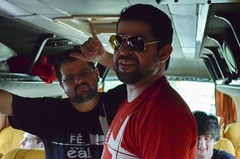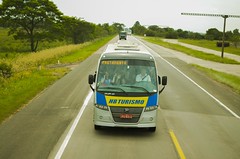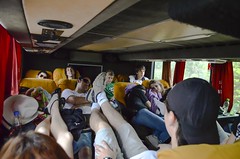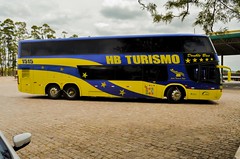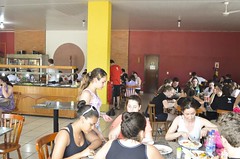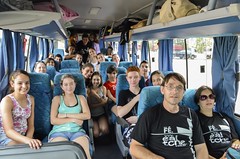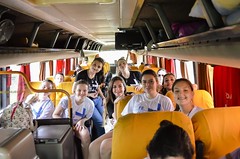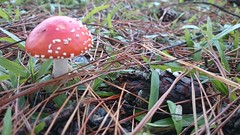Santa Maria
Santa Maria is a municipality (município) in the central region of Rio Grande do Sul, the southernmost state of Brazil. In 2020, its population was 283,677 inhabitants in a total area of . Santa Maria is the 5th biggest municipality in the state, and the largest in its micro-region.
Santa Maria is often referred to as the "heart of Rio Grande" (from Portuguese: "Coração do Rio Grande"), because the city is located in the geographical center of the State.
History and importance
The first inhabitants of Santa Maria were the Minuano Indigenous People, who lived in a region of the municipality known as Coxilha do Pau Fincado, and the Tapes, who lived in the hills.
With the arrival of Spanish and Portuguese colonizers this border region was witness to innumerable battles between rival groups. Finally, in 1797 the border between the two colonies was established by a commission (1ª Subdivisão da Comissão Demarcadora de Limites da América dat lit Meridional). This commission set up camp on the site of present-day Santa Maria.
The camp was known as Acampamento de Santa Maria, later adding Boca do Monte to the name. 1828 saw the arrival of the 28th Battalion of Foreigners, made up of hired Germans to fight against the inhabitants of present-day Uruguay in the Cisplatine War. After the war many of the soldiers decided to stay in Santa Maria, beginning the cycle of German colonization. In 1857, Santa Maria was separated from Cachoeira do Sul and elevated to town (''vila'') status. The municipality was created on 16 December 1857 and installed on 17 May 1858.
Since 1910, the city is the seat of the Roman Catholic Diocese of Santa Maria, and annually hosts an important Roman Catholic festival dedicated to Nossa Senhora Medianeira, called "Romaria da Medianeira" (Medianeira or Mediatrix is a name of Our Lady that was created in Venice, Italy). Every year, hundreds of thousands of people from all over Brazil join in the celebrations.
Due to its strategic geographical location, Santa Maria has a large military force, including the Santa Maria Air Force Base of the Brazilian Air Force, which houses four units, and the 3rd Army Division of the Southern Military Command. In 2011, the German defence company Krauss-Maffei Wegmann GmbH & Co. KG (KMW) closed a deal to renovate old tanks and produce new ones for the Brazilian Army, opening a factory in Santa Maria. This earned the city its new nickname, "Armoured Capital" (from Portuguese: Capital dos Blindados).
On 27 January 2013, a fire broke out in the ''Kiss"'' nightclub'' during a band performance, due to misuse of pyrotechnics, which got in direct contact with the acoustic foam used in the club. In total, 242 people died due to suffocation or trampling while trying to escape, or of complication in days and months following the event. It has been reported that as many as 1,500 people were in the nightclub when the fire broke out.
Population
Santa Maria is the fifth largest city in the state of Rio Grande do Sul, after Porto Alegre, Caxias do Sul, Pelotas, and Canoas. Many of the city's inhabitants are of German and Italian ancestries.
It is the largest city in the central region of the state, concentrating 36.40% of this region's population. During the period between 2000 and 2010, Santa Maria had a demographic growth rate of 6.00%.
The municipality contains 10 districts. The city of Santa Maria itself is located in the urban Seat District (Distrito Sede), which is divided into 8 regiões administrativas (administrative regions), and further subdivided into 40 bairros (neighbourhoods). About 95% of the municipality's total population is concentrated in the Seat District. One of the districts is Palma.
Quality of life
According to the United Nations (PNUD 2000), Santa Maria ranks 45th in quality of life in Brazil and 9th in the state. According to data from 2006, from Fundação de Economia e Estatística – FEE, life expectancy at birth is of 74.01 years and the demographic density of the municipality is .
The level of atmospheric pollution in Santa Maria is low, since the urban area, for the most part, is composed of retail commerce and services, without polluting sectors.
Paleontology
The city is the birthplace of paleontology in Rio Grande do Sul and Brazil. The Paleontological Sites of Santa Maria are internationally known. In 1902, a Rhynchosaur was collected in Santa Maria, one of the first fossil collections made in South America since Darwin's voyage on the Beagle between 1831 and 1836. Llewellyn Ivor Price, a Santa Maria-born paleontologist and one of the first Brazilian ones, collected a Staurikosaurus, the first Brazilian dinosaur. The city is located on a huge deposit of fossils, with more than 20 Paleontological Sites.
In October 2009, free distribution of one thousand copies of the book Vertebrados Fósseis de Santa Maria e Região (Vertebrate Fossils of Santa Maria and surrounding regions in English). The book will be delivered to institutions, schools and libraries in Santa Maria, in order to spread the teaching of this subject in the region. The book was published by the council of the city.
Already published two comic books with titles Xiru Lautério e Os Dinossauros I and II, in order to disclose the paleontology and gaucho culture among children of city and region.
External links
- [http://www.santamaria.rs.gov.br/ The city's official website ]
Looking for places related to Santa Maria?
Those are other destinations to find places related to Santa Maria:








